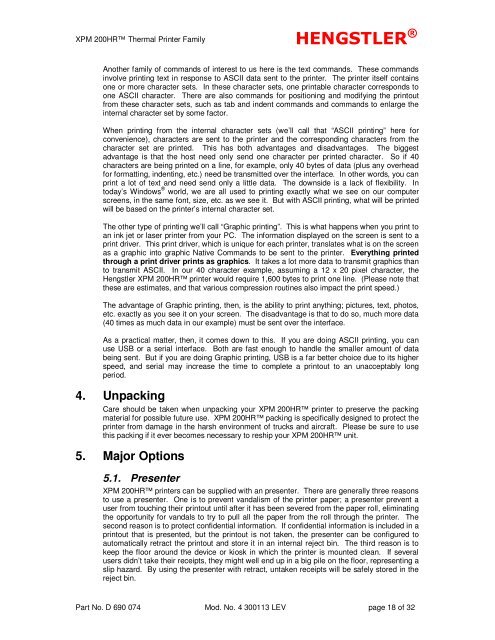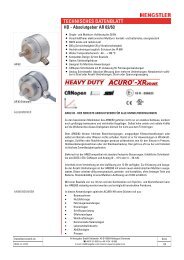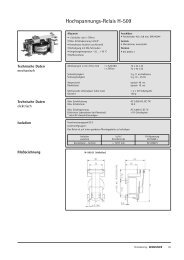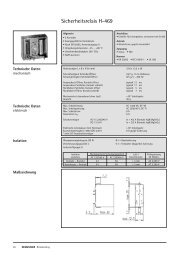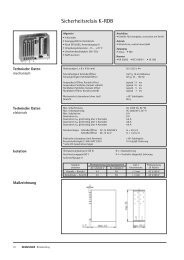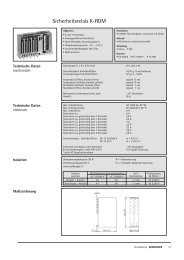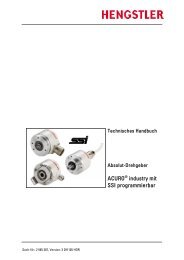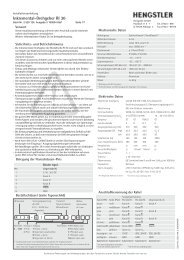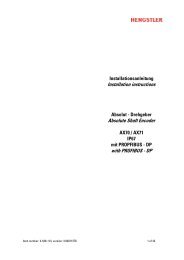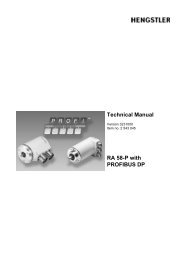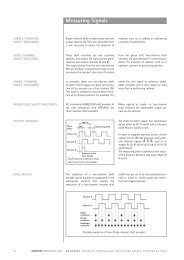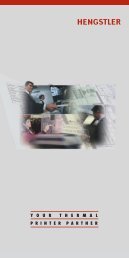XPM 200HR™ v1 - Hengstler GmbH
XPM 200HR™ v1 - Hengstler GmbH
XPM 200HR™ v1 - Hengstler GmbH
You also want an ePaper? Increase the reach of your titles
YUMPU automatically turns print PDFs into web optimized ePapers that Google loves.
<strong>XPM</strong> 200HR Thermal Printer Family HENGSTLER ®<br />
Another family of commands of interest to us here is the text commands. These commands<br />
involve printing text in response to ASCII data sent to the printer. The printer itself contains<br />
one or more character sets. In these character sets, one printable character corresponds to<br />
one ASCII character. There are also commands for positioning and modifying the printout<br />
from these character sets, such as tab and indent commands and commands to enlarge the<br />
internal character set by some factor.<br />
When printing from the internal character sets (we’ll call that “ASCII printing” here for<br />
convenience), characters are sent to the printer and the corresponding characters from the<br />
character set are printed. This has both advantages and disadvantages. The biggest<br />
advantage is that the host need only send one character per printed character. So if 40<br />
characters are being printed on a line, for example, only 40 bytes of data (plus any overhead<br />
for formatting, indenting, etc.) need be transmitted over the interface. In other words, you can<br />
print a lot of text and need send only a little data. The downside is a lack of flexibility. In<br />
today’s Windows ® world, we are all used to printing exactly what we see on our computer<br />
screens, in the same font, size, etc. as we see it. But with ASCII printing, what will be printed<br />
will be based on the printer’s internal character set.<br />
The other type of printing we’ll call “Graphic printing”. This is what happens when you print to<br />
an ink jet or laser printer from your PC. The information displayed on the screen is sent to a<br />
print driver. This print driver, which is unique for each printer, translates what is on the screen<br />
as a graphic into graphic Native Commands to be sent to the printer. Everything printed<br />
through a print driver prints as graphics. It takes a lot more data to transmit graphics than<br />
to transmit ASCII. In our 40 character example, assuming a 12 x 20 pixel character, the<br />
<strong>Hengstler</strong> <strong>XPM</strong> 200HR printer would require 1,600 bytes to print one line. (Please note that<br />
these are estimates, and that various compression routines also impact the print speed.)<br />
The advantage of Graphic printing, then, is the ability to print anything; pictures, text, photos,<br />
etc. exactly as you see it on your screen. The disadvantage is that to do so, much more data<br />
(40 times as much data in our example) must be sent over the interface.<br />
As a practical matter, then, it comes down to this. If you are doing ASCII printing, you can<br />
use USB or a serial interface. Both are fast enough to handle the smaller amount of data<br />
being sent. But if you are doing Graphic printing, USB is a far better choice due to its higher<br />
speed, and serial may increase the time to complete a printout to an unacceptably long<br />
period.<br />
4. Unpacking<br />
Care should be taken when unpacking your <strong>XPM</strong> 200HR printer to preserve the packing<br />
material for possible future use. <strong>XPM</strong> 200HR packing is specifically designed to protect the<br />
printer from damage in the harsh environment of trucks and aircraft. Please be sure to use<br />
this packing if it ever becomes necessary to reship your <strong>XPM</strong> 200HR unit.<br />
5. Major Options<br />
5.1. Presenter<br />
<strong>XPM</strong> 200HR printers can be supplied with an presenter. There are generally three reasons<br />
to use a presenter. One is to prevent vandalism of the printer paper; a presenter prevent a<br />
user from touching their printout until after it has been severed from the paper roll, eliminating<br />
the opportunity for vandals to try to pull all the paper from the roll through the printer. The<br />
second reason is to protect confidential information. If confidential information is included in a<br />
printout that is presented, but the printout is not taken, the presenter can be configured to<br />
automatically retract the printout and store it in an internal reject bin. The third reason is to<br />
keep the floor around the device or kiosk in which the printer is mounted clean. If several<br />
users didn’t take their receipts, they might well end up in a big pile on the floor, representing a<br />
slip hazard. By using the presenter with retract, untaken receipts will be safely stored in the<br />
reject bin.<br />
Part No. D 690 074 Mod. No. 4 300113 LEV page 18 of 32


